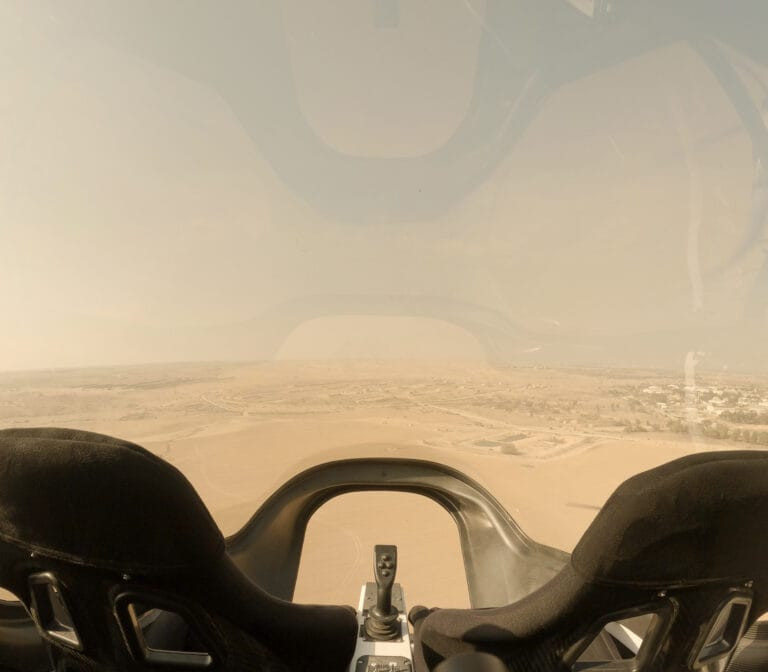N o longer confined to massive airports or daylight operations, a new tranche of electric vertical take-off and landing aircraft (eVTOLs) is demonstrating a different future—one where cargo moves seamlessly between locations without runways, human pilots, or daylight.
Making night flying routine
Operating aircraft at night in off-airport conditions has traditionally been the domain of manned missions with sophisticated support infrastructure. But Air’s cargo eVTOL has challenged that paradigm.
“Air’s cargo eVTOL leverages a combination of robust autonomous flight systems, optics, and precision navigation software for night operations,” Rani Plaut, CEO of Air, explained. “The aircraft’s integrated sensors and stabilisation systems enable safe take-off, landing (on a sloped surface), and routing in low-light, minimally equipped areas.” This is already happening. Air’s aircraft operate with minimal ground setup, a critical advantage when delivering goods to remote or austere environments. The company’s simplified ground interface allows non-specialist crews to execute seamless handoffs without relying on advanced infrastructure.
In other words, an eVTOL can land in a rural field at night, offload its cargo, and take off again—with no airport, no runway, and no pilot on board. “Safety is embedded through layered redundancy in flight control systems, real-time telemetry, and a fail-safe remote intervention capability,” Plaut said. “The aircraft also includes emergency return-to-base protocols and geofencing to avoid high-risk areas.”
For Plaut, the core challenge wasn’t building sophisticated tech—it was making it usable. Real-world exercises with first-time crews validated the approach taken and proved that intuitive design can enable reliable operations, even at night. “The main challenge was simplifying unfamiliar operating procedures: reducing what could be a technical handoff into a process that anyone can follow with minimal training,” he said. “Air addressed this by designing a one-page, visual SOP that clearly outlines safety zones, loading steps, and latching procedures.”
Race for logistics airspace
The sector is crowded with hopefuls, so what’s under the hood matters. Air’s umodel is based on the same platform as its piloted Air One aircraft. This shared architecture means faster iteration, easier certification, and better scalability. “Air distinguishes itself through modularity, simplicity, and real-world deployability with large volume (70 cu ft) and a payload of 550 lbs,” Plaut said. “Air has already delivered its first unit and proven operational capability in nighttime and real-world missions.
“Our uncrewed cargo variant benefits from the same scalable platform as the piloted Air One, allowing cross-segment maturity, faster deployment, and a lighter path to certification.”
The implications extend beyond e-commerce. With its ability to operate in challenging terrains and zero-infrastructure zones, the cargo eVTOL opens doors to humanitarian aid, rural connectivity, and defence logistics. “This is one of the most compelling use cases for Air’s technology,” said Plaut. “The ability to deliver on-demand cargo in low-infrastructure areas without runways, in rough terrain, or during power outages makes it ideal for humanitarian missions, rural connectivity, and defence logistics. Its night operation capability further extends its reach into urgent, around-the-clock supply scenarios.”
Regulatory confidence
When an uncrewed aircraft proves itself in low-light, real-world conditions, regulators pay attention, so the implications of successful night cargo flights are vast.
“Demonstrating safe, repeatable operations at night is a major milestone in gaining regulatory confidence,” Plaut said. “It shows system reliability in low-visibility conditions and proves that SOPs, human factors, system logic, and remote operations are mature.”
This level of maturity is critical as regulators like the FAA and EASA shape policy frameworks around advanced air mobility. According to Plaut, the data from these operations is directly influencing the certification process.
“Successfully completing cargo missions at night under real-world constraints provides valuable data to regulators. It helps define operational envelopes for uncrewed aircraft and may influence policy on BVLOS [beyond visual line of sight] and off-airport operations,” he said.





